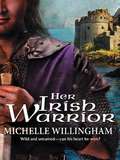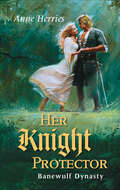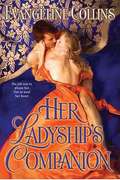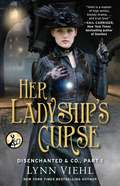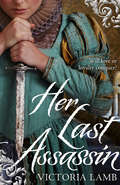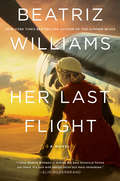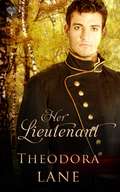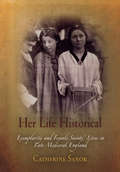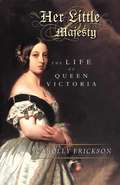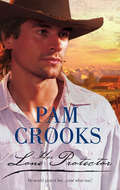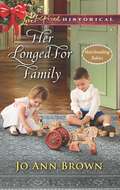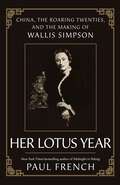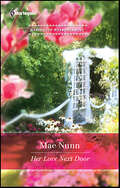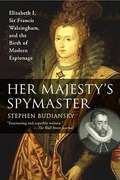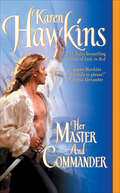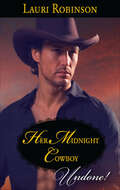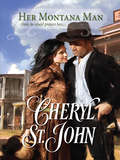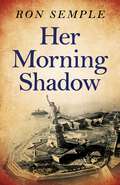- Table View
- List View
Her Irish Warrior
by Michelle WillinghamGenevieve de Renalt must escape her betrothed, even if that means putting her trust in the hands of the enemy!Irish warrior Bevan MacEgan cannot leave a lady in danger, but how far will he go to keep her safe? Marriage would benefit them both, yet he has sworn never to love again. . . ;. Proud and strong, he keeps Genevieve at a distance but, as she begins to melt his heart, a shocking discovery forces Bevan to make a choice-a choice that could mean losing her forever!
Her Kilt-Clad Rogue
by Julie MoffettEnglishwoman Genevieve Fitzsimmons never expected she'd return to the wilds of Scotland. And she certainly didn't expect to become governess to the son of Connor Douglas, the man with whom she shared her first kiss and her first heartbreak. The man who still intrigues her... For Connor, duty means everything. Years ago, it forced him to break Genevieve's heart and marry another woman-one who made him miserable. Now a widower at odds with his son, he's determined to put his heart first. As Connor and Genevieve begin to find their way toward a future together, they can't escape the past. Someone is bent upon revenge against Connor and his feelings for Genevieve make her the perfect target.Previously published, newly revised by author.33,000 words
Her Knight Protector (Banewulf Dynasty)
by Anne HerriesTo love, honor and...protectAlain de Banewulf may have triumphed by the strength of his sword during the Crusades, and returned home steeped in glory, but he needs to prove to himself that his skills as a knight lie beyond the battlefield.Alain’s life is set to change when he rescues Katherine of Grunwald from brigands. For Katherine is carrying a treasure desired by all of Christendom-one that men will kill for-and Alain has sworn to protect her from the perils that lie ahead. With Katherine’s help, perhaps Alain will come to realize that his honor depends not only on his bravery in the face of battle, but also on the strength of his love for one woman.
Her Lady's Honor: An Historical Lesbian Romance
by Renée DahliaThe war might be over, but the battle for love has just begun.When Lady Eleanor “Nell” St. George arrives in Wales after serving as a veterinarian in the Great War, she doesn’t come alone. With her is her former captain’s beloved warhorse, which she promised to return to him—and a series of recurring nightmares that torment both her heart and her soul. She wants only to complete her task, then find refuge with her family, but when Nell meets the captain’s eldest daughter, all that changes.Beatrice Hughes is resigned to life as the dutiful daughter. Her mother grieves for the sons she lost to war; the care of the household and remaining siblings falls to Beatrice, and she manages it with a practical efficiency. But when a beautiful stranger shows up with her father’s horse, practicality is the last thing on her mind.Despite the differences in their social standing, Beatrice and Nell give in to their unlikely attraction, finding love where they least expect it. But not everything in the captain’s house is as it seems. When Beatrice’s mother disappears under mysterious circumstances, Nell must overcome her preconceptions to help Beatrice, however she’s able. Together they must find out what really happened that stormy night in the village, before everything Beatrice loves is lost—including Nell.This book is approximately 82,000 wordsOne-click with confidence. This title is part of the Carina Press Romance Promise: all the romance you’re looking for with an HEA/HFN. It’s a promise!
Her Ladyship's Companion
by Evangeline CollinsCondemned to a loveless marriage, Lady Isabella Stirling indulges herself by taking a lover. But even though she knows Gideon Rosedale's passion was for sale, she's fallen in love with him.
Her Ladyship's Curse (Disenchanted & Co. #1)
by Lynn ViehlIn a steampunk version of America that lost the Revolutionary War, Charmian (Kit) Kittredge makes her living investigating magic crimes and exposing the frauds behind them. While Kit tries to avoid the nobs of high society, as the proprietor of Disenchanted & Co. she follows mysteries wherever they lead. Lady Diana Walsh calls on Kit to investigate and dispel the curse she believes responsible for carving hateful words into her own flesh as she sleeps. While Kit doesn’t believe in magic herself, she can’t refuse to help a woman subjected nightly to such vicious assaults. As Kit investigates the Walsh family, she becomes convinced that the attacks on Diana are part of a larger, more ominous plot—one that may involve the lady’s obnoxious husband. Sleuthing in the city of Rumsen is difficult enough, but soon Kit must also skirt the unwanted attentions of nefarious deathmage Lucien Dredmore and the unwelcome scrutiny of police Chief Inspector Thomas Doyle. Unwilling to surrender to either man’s passion for her, Kit struggles to remain independent as she draws closer to the heart of the mystery. Yet as she learns the truth behind her ladyship’s curse, Kit also uncovers a massive conspiracy that promises to ruin her life—and turn Rumsen into a s supernatural battleground from which no one will escape alive.
Her Last Assassin (Shakespeare’s Mistress #3)
by Victoria LambA gripping historical thriller set in Tudor England during the reign of Elizabeth I.Lady-in-waiting Lucy Morgan is once again torn between her dangerous attraction to William Shakespeare and her fierce loyalty to Queen Elizabeth I.But England is facing its gravest threat yet. The Spanish have declared war, and Elizabeth finds herself attacked by sea – and by Catholic conspiracy from within her own court. Master Goodluck goes undercover, tasked with discovering the identity of this secret assassin, leaving his ward Lucy not knowing if the spy is alive or dead. Meanwhile Queen Elizabeth is growing old in a court of troublesome young noblemen, while Lucy is struggling to love a man whose duties lie elsewhere.When the final challenge comes, these two women must be ready to face it. But there is one last surprise in store for both of them …
Her Last Flight: A Novel
by Beatriz WilliamsOne of Summer’s Most Anticipated Reads, according to Goodreads, SheReads, and Bookish“I think Beatriz Williams is writing the best historical fiction out there. It’s lush with period detail but feels immediate.”—Elin HilderbrandThe beloved author returns with a remarkable novel of both raw suspense and lyric beauty— the story of a lost pilot and a wartime photographer that will leave its mark on your soul. In 1947, photographer and war correspondent Janey Everett arrives at a remote surfing village on the Hawaiian island of Kauai to research a planned biography of forgotten aviation pioneer Sam Mallory, who joined the loyalist forces in the Spanish Civil War and never returned. Obsessed with Sam’s fate, Janey has tracked down Irene Lindquist, the owner of a local island-hopping airline, whom she believes might actually be the legendary Irene Foster, Mallory’s onetime student and flying partner. Foster’s disappearance during a round-the-world flight in 1937 remains one of the world’s greatest unsolved mysteries. At first, the flinty Mrs. Lindquist denies any connection to Foster. But Janey informs her that the wreck of Sam Mallory’s airplane has recently been discovered in a Spanish desert, and piece by piece, the details of Foster’s extraordinary life emerge: from the beginnings of her flying career in Southern California, to her complicated, passionate relationship with Mallory, to the collapse of her marriage to her aggressive career manager, the publishing scion George Morrow.As Irene spins her tale to its searing conclusion, Janey’s past gathers its own power. The duel between the two women takes a heartstopping turn. To whom does Mallory rightfully belong? Can we ever come to terms with the loss of those we love, and the lives we might have lived?
Her Leading Man: 1900s Historical Romance (The Dream Maker Series #4)
by Alice DuncanChristina Mayhew doesn't consider herself a gifted thespian. Acting in Silent Films is simply a means to earn money for medical school so she can become a physician like her beloved father. Thankfully her gentlemanly producer, Martin Tafft, understands.While Martin is happy to discuss feminism and women's suffrage with Christina, his inner reaction to her secret goal is one of crushing disappointment. With moving pictures developing a sordid reputation, thanks to hard-drinking and drug-consuming stars, he needs Christina's wholesomeness to create the kind of movies he envisions.Then an accident on the set forces Martin to take the male lead, and Christina gets a taste of his kisses--on screen, at least. Now all she has to do is convince him he is perfect for another role... her lifetime leading man.REVIEWS:"The setting is fascinating, and so authentically drawn, transporting me to the world of early Hollywood. The love scenes are very emotional and very hot." ~Kate McMurry"Very highly recommended!" ~Cindy Penn, WordweavingTHE DREAM MAKER SERIES, in order Cowboy for HireBeauty and the BrainThe Miner's DaughterHer Leading Man
Her Legendary Highlander (Lovers and Legends #13)
by Nicole LockeHer rugged prisoner…becomes her fiercest protector Capturing legendary Highlander Malcolm of Clan Colquhoun was Andreona&’s last chance to win her tyrannical father&’s respect. Instead he orders them both to be killed! Resigned to her devastating role as the family outcast, she and her prisoner escape and continue on his quest to return a treasured heirloom. They find solace in their unexpected passion, but haunted by a lifetime of betrayals, will either dare to hope it could last beyond their journey?From Harlequin Historical: Your romantic escape to the past.Lovers and LegendsBook 1: The Knight's Broken PromiseBook 2: Her Enemy HighlanderBook 3: The Highland Laird's BrideBook 4: In Debt to the Enemy LordBook 5: The Knight's Scarred MaidenBook 6: Her Christmas KnightBook 7: Reclaimed by the KnightBook 8: Her Dark Knight's RedemptionBook 9: Captured by Her Enemy KnightBook 10: The Maiden and the MercenaryBook 11: The Knight's Runaway MaidenBook 12: Her Honorable MercenaryBook 13: Her Legendary Highlander
Her Lessons in Persuasion: A School for Scoundrels Novel (School for Scoundrels #1)
by Megan FramptonMegan Frampton dazzles in the first book in her new series, A School for Scoundrels. Five gentlemen with unbreakable bonds navigate life—and love—in London. Perfect for fans of Sarah MacLean and anyone who loves BRIDGERTON! To Lady Wilhelmina Bettesford, the “game” of finding a husband is a competitive sport she wants no part of…until her much-younger step mama forces her to play it. So when her stepmother asks sexy barrister Bram Townsend to pretend to woo the amateur astronomer to boost Wilhelmina’s popularity, it’s up to Wilhelmina to navigate a fake courtship that will keep the family from forcing her into a marriage—any marriage—before she finally receives the inheritance that will allow her to live as she wants.The trouble is every time Bram takes her in his arms she has a most difficult time remembering theirs is an act…the make-believe passion feels very real indeed. Bram Townsend is a man on the way up: living for his books and his beliefs. Squiring Lady Wilhelmina through London’s dusk-to-dawn social whirl is hardly an ordeal—she’s beautiful, bright, and bold, everything he finds tempting in a woman. Their deal means he can meet the “best” people while she keeps her family at bay. The challenge is he quickly finds himself wanting her to say “yes” when she’s so determined to say “no.” She persuaded him to make this impetuous bargain, but how can he convince her to make it real?
Her Lieutenant
by Theodora LaneIn Russia, during the 1600’s, the place of a duke’s daughter was to marry whomever her father chose for her. Lady Arisha Bagry, disgraced, ruined, and exiled to a small town, has learned to survive on her own, without any man telling her what to do, and she’s content living her life alone. Even if it means she’ll never have a husband or children. When Lieutenant Alexei Zolvar is sent to retrieve the duke’s daughter, he’s furious. He should be at the front, leading the fight against the Turks. It feels more like a punishment than a plum assignment, but he knows his duty. He is ordered and he must obey. He is determined to bring the duke’s daughter home. She is determined to never return. For both of them, this mission becomes one of life or death. However, not just their lives hang in the balance. Who will live and who will die? And who can know how far a madman will go?
Her Life Historical
by Catherine SanokHer Life Historical offers a major reconsideration of one of the most popular narrative forms in late medieval England--the lives of female saints--and one of the period's primary modes of interpretation--exemplarity. With lucidity and insight, Catherine Sanok shows that saints' legends served as vehicles for complex considerations of historical difference and continuity in an era of political crisis and social change. At the same time, they played a significant role in women's increasing visibility in late medieval literary culture by imagining a specifically feminine audience.Sanok proposes a new way to understand exemplarity--the repeated injunction to imitate the saints--not simply as a prescriptive mode of reading but as an encouragement to historical reflection. With groundbreaking originality, she argues that late medieval writers and readers used religious narrative, and specifically the legends of female saints, to think about the historicity of their own ethical lives and of the communities they inhabited. She explains how these narratives were used in the fifteenth century to negotiate the urgent social concerns occasioned by political instability and dynastic conflict, by the threat of heresy and the changing status of public religion, and by new kinds of social mobility and forms of collective identity.Her Life Historical also offers a fresh account of how women came to be visible participants in late medieval literary culture. The expectation that they formed a distinct audience for saints' lives and moral literature allowed medieval women to surface in the historical record as book owners, patrons, and readers. Saints' lives thereby helped to invent the idea of a gendered audience with a privileged affiliation and a specific response to a given narrative tradition.
Her Little Majesty: The Life of Queen Victoria
by Carolly EricksonA Simon & Schuster eBook. Simon & Schuster has a great book for every reader.
Her Lone Protector
by Pam CrooksFighting for freedom...Hardened mercenary and fierce patriot Creed Sherman returns home, only to discover his childhood sweetheart married to his father! Hurt and betrayed, he means to leave America for good. Until he braves fire to save the life of Gina Briganti, an alluring Italian immigrant.Fighting for love...Captivated by her beauty, moved by her plight, he vows to protect Gina and bring her justice. But can this passionate man forget his past to give them both a bright new future?
Her Longed-For Family
by Jo Ann BrownMeant-to-Be Mother Lady Caroline Trelawney Dowling has always wanted a child of her own and her wish comes true when two abandoned children are temporarily turned over to her. She's finding new purpose and joy-even more so after the handsome baron next door requests her help in renovating his house and refining his manners. As the new Lord Warrick, Jacob has a host of duties, including updating his estate and providing an heir. Lady Caroline's expertise in etiquette proves invaluable, and spending time together is a delight. But as the children's origins are finally uncovered, can he keep her newfound family intact-and unite her dreams with his own? Matchmaking Babies: Seeking forever families and speeding up the course of true love
Her Lost Words: A Novel of Mary Wollstonecraft and Mary Shelley
by Stephanie Marie ThorntonFrom A Vindication of the Rights of Woman to Frankenstein, a tale of two literary legends—a mother and daughter—discovering each other and finding themselves along the way, from USA Today bestselling author Stephanie Marie Thornton. 1792. As a child, Mary Wollstonecraft longed to disappear during her father&’s violent rages. Instead, she transforms herself into the radical author of the landmark volume A Vindication of the Rights of Woman, in which she dares to propose that women are equal to men. From conservative England to the blood-drenched streets of revolutionary France, Mary refuses to bow to society&’s conventions and instead supports herself with her pen until an illicit love affair challenges her every belief about romance and marriage. When she gives birth to a daughter and is stricken with childbed fever, Mary fears it will be her many critics who recount her life&’s extraordinary odyssey… 1818. The daughter of infamous political philosopher Mary Wollstonecraft, passionate Mary Shelley learned to read by tracing the letters of her mother&’s tombstone. As a young woman, she desperately misses her mother&’s guidance, especially following her scandalous elopement with dashing poet Percy Bysshe Shelley. Mary struggles to balance an ever-complicated marriage with motherhood while nursing twin hopes that she might write something of her own one day and also discover the truth of her mother&’s unconventional life. Mary&’s journey will unlock her mother&’s secrets, all while leading to her own destiny as the groundbreaking author of Frankenstein. A riveting and inspiring novel about a firebrand feminist, her visionary daughter, and the many ways their words transformed our world.
Her Lotus Year: China, the Roaring Twenties, and the Making of Wallis Simpson
by Paul FrenchNew York Times bestselling author Paul French examines a controversial and revealing period in the early life of the legendary Wallis, Duchess of Windsor–her one year in China.Before she was the Duchess of Windsor, Bessie Wallis Warfield was Mrs. Wallis Spencer, wife of Earl “Win” Spencer, a US Navy aviator. From humble beginnings in Baltimore, she rose to marry a man who gave up his throne for her. But what made Wallis Spencer, Navy Wife, the woman who could become the Duchess of Windsor? The answers lie in her one-year sojourn in China. In her memoirs, Wallis described her time in China as her “Lotus Year,” referring to Homer’s Lotus Eaters, a group living in a state of dreamy forgetfulness, never to return home. Though faced with challenges, Wallis came to appreciate traditional Chinese aesthetics. China molded her in terms of her style and provided her with friendships that lasted a lifetime. But that “Lotus Year” would also later be used to damn her in the eyes of the British Establishment. The British government’s supposed “China Dossier” of Wallis’s rumored amorous and immoral activities in the Far East was a damning concoction, portraying her as sordid, debauched, influenced by foreign agents, and unfit to marry a king. Instead, French, an award-winning China historian, reveals Wallis Warfield Spencer as a woman of tremendous courage who may have acted as a courier for the US government, undertaking dangerous undercover diplomatic missions in a China torn by civil war. Her Lotus Year is an untold story in the colorful life of a woman too often maligned by history.
Her Love Next Door
by Mae NunnAfter an injury ended her dance career, Jessica Holliday became a landscape designer. So when a society wedding gives her the chance to make a name for herself, she vows to get the job done without help from anyone-especially handsome newcomer Captain Andrew Keegan.Though his neighbor may be beautiful, even with dirt under her nails, Drew Keegan has to do what he feels is right-by marrying the socialite of his father's choosing, he'll be able to help those who need it most. But when Jessica's livelihood is jeopardized, Drew begins to see his goals-and Jessica-in a new light.
Her Majesty's Inspectorate of Schools Since 1944: Standard Bearers or Turbulent Priests?
by John E. DunfordThis history of HMI since World War II shows how its independence derives from the work of the 19th century inspectors and examines the relationship between HMI and school, local education authorities and the government. It considers the effect of the 1988 and 1992 Education Acts.
Her Majesty's Spymaster
by Stephen BudianskyQueen Elizabeth I and England's First Spymaster Sir Francis Walsingham's official title was principal secretary to Queen Elizabeth I, but in fact this pious, tight-lipped Puritan was England's first spymaster. A ruthless, fiercely loyal civil servant, Walsingham worked brilliantly behind the scenes to foil Elizabeth's rival Mary Queen of Scots and outwit Catholic Spain and France, which had arrayed their forces behind her. Though he cut an incongruous figure in Elizabeth's worldly court, Walsingham managed to win the trust of key players like William Cecil and the Earl of Leicester before launching his own secret campaign against the queen's enemies. Covert operations were Walsingham's genius; he pioneered techniques for exploiting double agents, spreading disinformation, and deciphering codes with the latest code-breaking science that remain staples of international espionage.
Her Master and Commander
by Karen HawkinsA widow is recruited to turn a former pirate into a gentleman worthy of the title he will inherit in this Regency from a New York Times bestselling author.Dying without legitimate issue, the late Earl of Rochester sent his butler extraordinaire, Reeves, to find his wild, illegitimate children and “civilize” them. Reeves must seek out the first of the earl’s arrogant sons, Captain Tristan Llevanth, a one-time pirate, and teach him to be a gentleman.Wounded, Tristan Llevanth will never again sail the seas he loves. Life has no more challenges. Or so he thinks, until Reeves brings a certain outspoken lady into the captain’s uncultured household . . .Reeves believes Tristan needs a spark to relight the fires of his soul. And who better than lovely Prudence Thistlewaite, the bane of the captain’s existence? Prudence wants nothing to do with her wickedly handsome, ill-tempered neighbor. Still, she cannot refuse the outlandish sum Reeves offers to smooth Tristan’s rough edges. Can Prudence tame the rakish captain?
Her Midnight Cowboy (Undone!)
by Lauri RobinsonEastern Wyoming, 1884In Angel Clayton's opinion, men don't get any finer than hired hand Rowdy McGuire. The very thought of him makes her ache with need--and the sight of his golden, glistening skin only makes it worse. She knows he feels their bodies' magical, intense pull towards one another, even if the honorable cowboy refuses to admit that a drifter and a ranch owner's daughter could ever be together.But Angel is determined to get what she wants--and she wants Rowdy!
Her Montana Man
by Cheryl St. JohnProtecting people runs through Jonas Black's blood, and Eliza Jane Sutherland is one woman who needs his strong arms around her. A rugged Montana man, Jonas will guard Eliza from her vile brother-in-law as fiercely as he guards his own heart. But though he can fight her enemies, he can't fight the attraction between them. Soon Jonas is sure they have a future together--only Eliza hides secrets that could change everything. . . .
Her Morning Shadow
by Ron SempleWar and chaos are no match for an American immigrant bent on keeping a promise... Sequel to the award-winning Black Tom: Terror on the Hudson, Her Morning Shadow tells of a young Jewish Ukrainian immigrant, caught up in the aftershock of World War One. Private 'Abie' Ashansky is trying to build a new life in his adopted home in Jersey City, while searching for his missing fiancée. Spanning continents and relationships, this extraordinary account of one man's journey reveals a community where family is defined not only by blood but by the values and roots on which it is built. 'Buckle down for a wild saga in history that starts in the Great War and charges through the three-way battle for the Crimea and the Ukraine to reach its beacon, the torch of Liberty. A superb alloy of genuine history and vivid imagination.' Leslie Wilbur, Emeritus Professor, University of Southern California.
